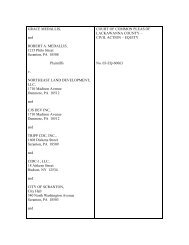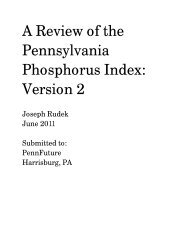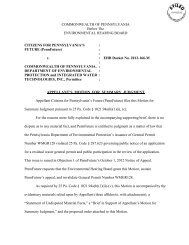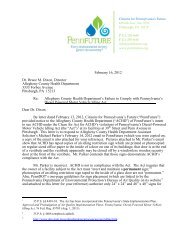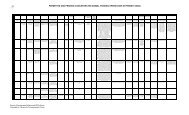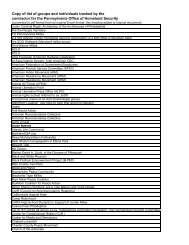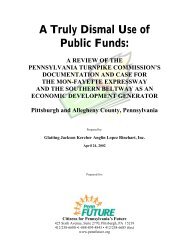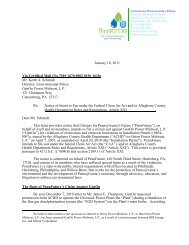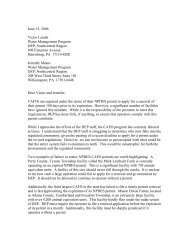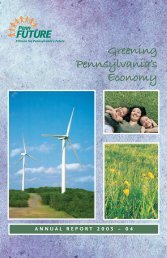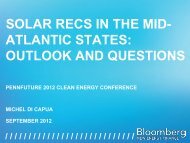Janine Migden-Ostrander - PennFuture
Janine Migden-Ostrander - PennFuture
Janine Migden-Ostrander - PennFuture
- No tags were found...
Create successful ePaper yourself
Turn your PDF publications into a flip-book with our unique Google optimized e-Paper software.
MAKING EFFICIENCY WORKFOR UTILITIESBYJANINE MIGDEN-OSTRANDER, PRINCIPALREGULATORY ASSISTANCE PROJECTPENNFUTURE CLEAN ENERGY CONFERENCEPHILADELPHIA, PENNSYLVANIASeptember 14, 2012The Regulatory Assistance ProjectHome Office (US)50 State Street, Suite 3Montpelier, VT 05602Phone: 802-223-8199web: www.raponline.org
The Regulatory Assistance Project (RAP)We are a global, non-profit team of expertsfocused on the long-term economic andenvironmental sustainability of the power andnatural gas sectors, providing assistance togovernment officials on a broad range of energyand environmental issues.2
About RAP – USRAP provides technical and policy support at the federal, stateand regional levels, advising utility and air regulators and theirstaffs, legislators, governors, other officials and nationalorganizations.We help states achieve ambitious energy efficiency andrenewable energy targets and we provide tailored analysis andrecommendations on topics such as ratemaking, smart grid,decoupling and clean energy resources. RAP publishes papers onemerging regulatory issues and we conduct state-by-stateresearch that tracks policy implementation.3
Balancing Energy EfficiencyEnergy Efficiency benefits consumers because it is theleast cost option for the system and providesopportunities for individual consumers to reduce theirenergy bills.The question is finding the right balance to encourageutilities to choose energy efficiency over moreexpensive supply side options to meet reliability needswhile considering the cost to consumers.4
The Three-Legged StoolUtilities are in the business of selling kilowatt hours to earnrevenues and not telling customers to buy less of their product.(Who does this and remains in business?)In order to make the utility whole, it must recover each of thefollowing:1. Program and administrative costs )2. Lost revenues )3. Incentive payments )The three legs of the stool5
Program and Administrative CostsReasonable and prudently incurred utility costsincurred in offering energy efficiency can berecovered in the following manner:1. Recovered in a rate case2. Expensed through a rider3. Amortized over a period of years andrecovered through a rider6
Program and Administrative Costs:Recovery in a Rate Case• Preserves traditional ratemaking as the vehicle forcost recovery• May result in more frequent rate cases/more utilityaccountability• Can create a disincentive for increasing energyefficiency beyond test year levels if no ability torecover costs above the amount set in a rate case• Conversely, it can result in over-recovery if the utilityscales back on the amount recoverable in rates7
Program and Administrative Expenses:Expensed Through a Rider• Allows more contemporaneous recovery with whenthe cost is incurred• Dollar-for-dollar recovery of Commission-approvedcosts• Does not require a rate case where decreases in costcan offset increase in rates for Energy Efficiencysavings• Allows utility to more easily ramp-up utilityinvestment in Energy Efficiency8
Program and Administrative Expenses:Amortized Over a Period of Years andExpensed Through a Rider• Allows for recovery of actual costs• Reduces the impact of energy efficiencyinvestments by allowing a longer time periodfor recovery• Adds an interest component that customersmust pay for extending the recovery period9
Lost RevenuesRecovery of lost revenues allows the utility to recoverrevenues the Commission has determined through aproceeding that the utility needs in order to cover all itsexpenses and earn a reasonable return on itsinvestment for shareholders.When utilities encourage customers to use less,thereby reducing sales, it impacts their ability to reachtheir targeted revenue requirements.10
Mechanisms For Cost-Recovery of LostRevenues from Energy Efficiency• Lost revenue adjustment mechanism (LRAM)• Straight fixed variable rates (SFV)• Decoupling11
Lost Revenue Adjustment Mechanism• LRAM requires a regulatory review andanalysis of every program and documentsenergy savings from each program todetermine utility lost revenues• Importance of Evaluation, Monitoring andVerification (EM&V)• Reduced sales from Energy Efficiency x rate =utility lost revenues12
Pros & Cons of LRAM• Does not change the utility culture to promote sales• Requires rigorous regulatory review to accuratelydetermine lost revenue amounts which could result inprotracted litigation between the utility and consumergroups• Does not remove risk from utility of obtaining revenuerequirements• Allows utility to keep profits from new sales providingextra revenues for the utility (no netting of increasedsales from growth against decreased sales from energyefficiency)13
Straight Fixed Variable Rates (SFV)• SFV allows the utility to recover its revenuerequirements through a fixed charge fordistribution. It can eliminate or significantlyreduce the volumetric component of rates.Examples:‣ 100% fixed charge, no volumetric component‣ 70% fixed charge, 30% volumetric component14
Pros and Cons of SFV• SFV fails to provide price signals to conserve• SFV increases the payback for consumers investing in energyefficiency• SFV creates social justice problems as customers living in asmall apartment pay the same rate as customers living in alarge McMansion• SFV sometimes referred to as the “all you can eat” rate• Reduces risk for utility by guaranteeing revenues• Utility keeps any over-recovery of revenues• Requires rate case to increase rates15
Decoupling• Decoupling separates sales from revenues and isbased on a fully vetted cost of service determination• Decoupling maintains the current utility rate designof a small fixed rate plus a volumetric energy charge• At the end of an agreed upon period, the utility’sauthorized revenue requirements are measuredagainst actual revenues• Rates are often reconciled through a rider to allowutility to recover (or pay to customers) the differencebetween revenues authorized and revenues received16
How Decoupling WorksPeriodic Decoupling CalculationFrom the Rate CaseTarget Revenues $10,000,000Test Year Unit Sales 100,000,000Price $0.10000Post Rate Case CalculationActual Unit Sales 99,500,000Required Total Price $0.1005025Decoupling Price "Adjustment" $0.000502517
Impact of Decoupling on Rates2523Number of annual rate adjustments20151050RefundSurcharge13127 765432221100>3% ≤3% ≤2% ≤1% ≤1% ≤2% ≤3% >3%Decoupling rate adjustmentGasElectric18
Pros and Cons of Decoupling• Decoupling viewed with disfavor by consumersbecause it guarantees the utility the revenuelevel as approved in its last rate case• Decoupling reduces risk by assuring revenues• Just as utility recovers its revenue requirements,decoupling protects customers from overrecovery• Decoupling sends the appropriate price signals toconserve by retaining the volumetric charge19
Comparison of Regulation and DecouplingIssue Traditional Regulations DecouplingRevenue Requirement Cost of service Same, but may allow a “revenuepath” between rate casesLikelihood allowed revenuerequirement will be over-or-undercollectedWeather riskEconomic cycle riskNeed for rate casesHighCustomers and company bearweather risk with opposite “signs;”Results in wealth transfers based onweatherCompany primarily bears economicrisk cycleLikely need more often whengrowth or other factors arechangingLow-revenue collected equals“target” revenueCustomers and company shieldedfrom weather risk; Earnings stabilitymeans lower equity ratio required.Company shielded from risk; Resultsin lower cost of capitalReduced to 3-5 year periodicity atcommission’s discretionRate Design See company’s current rate design No change required, but incomestability concerns addressed20
Utility Incentives• Utilities receive a return on investment for shareholders whenbuilding new power plants• To encourage utilities to choose energy efficiency, incentivepayments have been approved by many commissions (goal isto make it an organic part of utility business plan)• Incentives allow utilities to keep some of the savings resultingfrom energy efficiency (“shared savings”)• Incentives offer a new revenue source for distribution onlycompanies that have limited opportunities to maximizeearnings• Has the potential to provide more immediate returns21
Types of Incentive Mechanisms• No Incentives – Supported by someconsumer groups (residential and/orindustrial) concerned about higher rates• Shared Net Benefits – utility receives ashare of the deemed net resourcebenefit for the life of the measure orsome other designated period of time22
Types of Incentive Mechanisms (cont’d)• Program Cost Bonus – Utility receives ashare of the annual portfolio’s programadministrative and measure incentive costs• Cost Capitalization – Utility receives anadditional rate of return on the capitalizedinvestment in energy efficiency23
Design of Incentive MechanismsFrequently, incentive mechanisms contain aperformance component so that higher energyefficiency levels produce higher returns for the utility.See example below:‣ Incentive level set at 7.5% for 80-99% of goal‣ Incentive level set at 10% for 100-114% of goal‣ Incentive level set at 15% for exceeding 115% of goalNote – Depending on size of target, providing anincentive for less than 100% compliance could bequestionable.24
ConclusionParticipating in regulatory processes is key toadvancing energy efficiencyPotential forums include:Rate ProceedingsIntegrated Resource ProceedingsCollaborativesOther25
About RAPThe Regulatory Assistance Project (RAP) is a global, non-profit team of experts thatfocuses on the long-term economic and environmental sustainability of the powerand natural gas sectors. RAP has deep expertise in regulatory and market policiesthat:• Promote economic efficiency• Protect the environment• Ensure system reliability• Allocate system benefits fairly among all consumersLearn more about RAP at www.raponline.org




